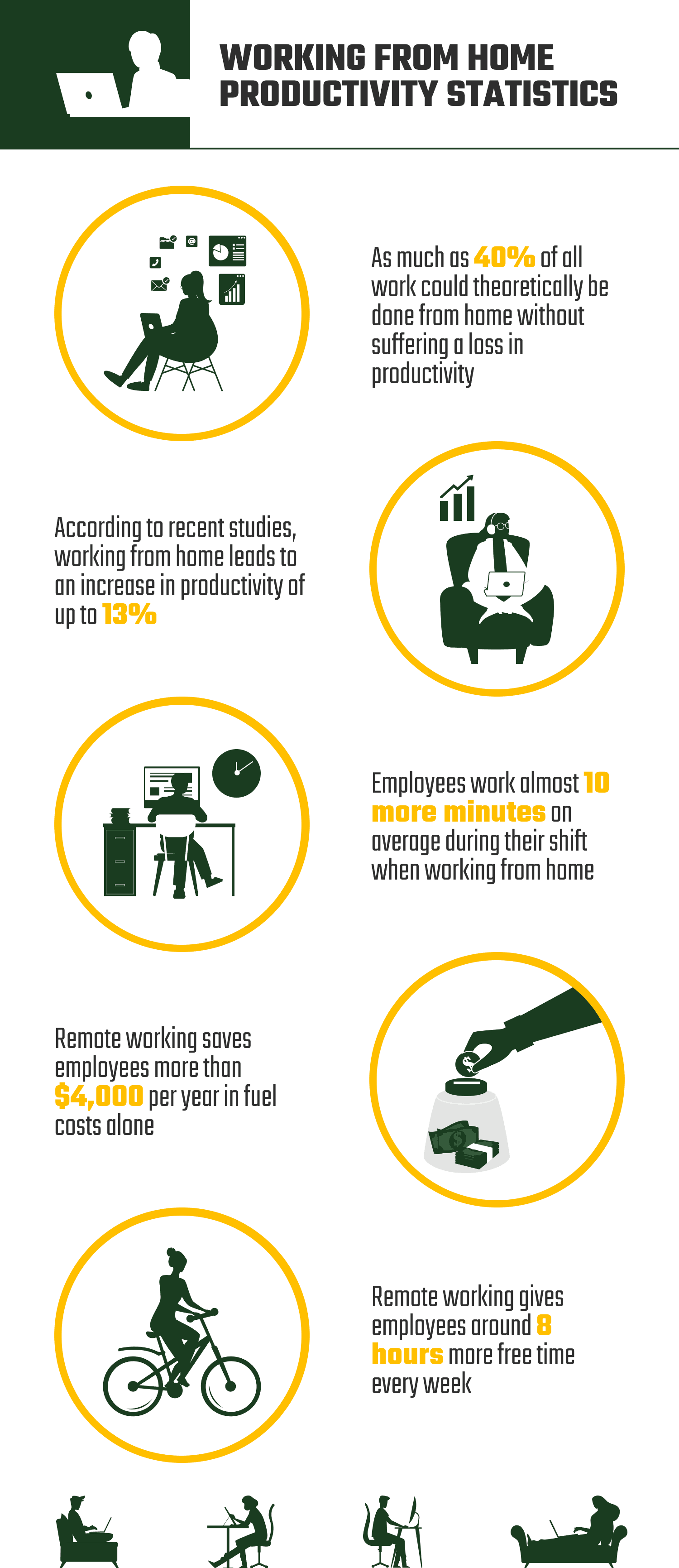14 Working From Home Productivity Statistics – 2023 Update
-
- Last updated:

Note: This article’s statistics come from third-party sources and do not represent the opinions of this website.
Stay-at-home orders meant that a much larger proportion of the population of the USA and the larger global population worked from home. Home offices were constructed on the kitchen table and Zoom meetings were conducted from spare rooms, but figures suggest that there had already been a considerable shift towards working from home. One of the biggest obstacles to home working is employers’ beliefs that it will lead to a loss in productivity, but studies suggest that the reverse is true: remote work productivity tends to be higher than office work productivity.
Click below to jump ahead:

The 14 Working From Home Productivity Statistics
- 6% of workers worked primarily from home before the pandemic
- As much as 40% of all work could theoretically be done from home
- 35% of workers did work from home in May 2020
- 71% of workers who can fulfil their duties remotely, worked from home in 2020
- 54% said that they wanted to continue to do so after the pandemic
- US employers expect nearly 1 in 5 of their workforce to be remote following the pandemic
- Working from home leads to an increase in productivity of 13%
- Employees worked 9% more minutes during their shift when working from home
- Staff churn is 50% lower from employees that worked from home
- Productivity was up 47% in 2020, despite a sharp increase in Covid-led working from home
- The greatest obstacle to working from home is motivation
- Remote working saves employees more than $4,000 per year
- Remote working gives employees an extra 8.5 hours of free time every week
- Only 61% of remote workers said it is easy to focus, compared to 71% of office workers


General Home Working Figures
1. 6% of workers worked primarily from home before the pandemic
(NCCI)
The Covid pandemic forced a lot of companies to rethink the way they did business and working from home became standard. Prior to 2020, it is estimated that 6% of the US workforce worked primarily from home. This figure had increased from 4% of employees that worked from home in 2009. These figures do not include people that took work home or answered work emails while at home: the Bureau of Labor Statistics considers employees that answer emails from home to have done some remote work.
Approximately 75% said that they had never worked from home.

2. As much as 40% of all work could theoretically be done from home
(McKinsey)
Not all jobs can be done remotely. Construction work, for example, needs to be done on site. Also, some roles within certain industries might demand some time at the physical workplace but offer the potential for some remote work, called a hybrid working model. Retail managers would be able to plan and report from home but still need to work from the retail site some days of the week.
It is estimated that 1 in 5 US workers would be able to work from home between three and five days a week and that the workforce of advanced economies would be able to conduct approximately 30% of their work from home without suffering a loss in productivity. It is also believed that a further 10% of work could be done from home if necessary.
This means that a total of 40% of work could be conducted from home if required.
3. 35% of workers did work from home in May 2020
(NCCI)
When stay-at-home orders were put in place in 2020, because of the spread of the Covid pandemic, it meant that people were not permitted to leave their home except to go to work if they could not conduct their work from home. During this time, 35% of US workers did work from home – this figure does not include those that would have otherwise worked remotely, equating to a further 6%, meaning that 41% of the population worked remotely, in line with the 40% estimate above.

4. 71% of workers who can fulfill their duties remotely, worked from home in 2020
(Pew Research)
Although it is widely believed that the pandemic will lead to long-term adoption of working from home standards, it isn’t necessarily true that all employees will adopt the new working life.
71% of those that can work from home do so at least most of the time.
5. 54% said that they wanted to continue to do so after the pandemic
(Pew Research)
Of those that can do their work from home, more than half (54%) said that they want to continue to do so after the pandemic. Some of the main reasons for not wanting to work from home are a lack of motivation and not being able to work without interruptions.

6. US employers expect most of their workforce to continue working from home after the pandemic
(PWC)
83% of office workers say that they want to work from home at least one day a week, after the pandemic. Most employers seem willing to facilitate this change, too, with 55% staying that they anticipate most workers will continue to complete at least some of their work remotely. Only 11% of businesses say that few or none of their employees will work in this way.
Work From Home vs Office Productivity
7. Home working leads to an increase in productivity of 13%
(Stanford)
One of the biggest employer concerns with the remote working model is that it leads to a downturn in productivity. However, studies show that home working actually leads to a 13% increase in productivity. A 9% increase was gained from employees working additional minutes per shift, and a further 4% increase was gained by employees making more calls per minute.

8. Employees worked 9% more minutes during their shift when working from home
(Stanford)
Homeworkers don’t have to commute to work, can take less time getting ready, and can therefore be sat working sooner. They are also seemingly more willing to put in the hours at the desk, with homeworkers completing an additional 9 minutes every working day, on average. Home workers, on average, took less time off sick, and shorter breaks, and had less time off overall.
9. Staff churn is 50% lower from employees that worked from home
(Stanford)
Another possible reason for improved productivity is improved happiness and satisfaction at work, as evidenced by the fact that staff attrition rates drop by 50%. Not only does less staff churn mean more work but it means less time having to advertise and interview for jobs, as well as less time training new employees to do their work.
However, despite being more productive and taking less time off, home workers are less likely to be promoted.

10. Productivity was up 47% in 2020, despite a sharp increase in Covid-led working from home
(Business Wire)
2020 was an extraordinary year and it saw major shifts in many aspects of peoples’ lives. Although a lot of businesses were initially worried about transitioning to working from home, their fears can be allayed by the fact that productivity was up 47% for the 12 months of 2020.
Comparing March and April 2020 to the same months of 2019, telephone calls increased by 230%, email activity was up 57%, and chat message frequency increased 9%, showing that employees were communicating with one another.
Obstacles And Rewards
11. The greatest obstacle to working from home is motivation
(Pew Research)
The Coronavirus pandemic led to increased anxiety and stress in a lot of employees. It also saw children being kept home from school, and some houses had multiple people working from home. Of those that worked from home, 36% said that they found staying motivated to be challenging. 32% said that working without being interrupted was difficult. Other challenges included having a suitable place to do work, meeting deadlines, and having the equipment they needed to be able to work.

12. Remote working saves employees more than $4,000 per year
(Airtasker)
A remote worker costs a company less in real estate, utilities, and other overheads, than an on-site worker. As such, it is in the financial interest of employers to allow remote work, where it is practically viable and where it doesn’t cause a loss of productivity. Similarly, remote working saves employees money, too. The average employee pays nearly $100 in fuel per week, which equates to over $4,500 per annum, and that’s without taking into account the extra cost of car maintenance, parking, and any other extras.
13. Remote working gives employees an extra 8.5 hours of free time every week
(Airtasker)
Despite the fact that remote workers work for 21.9 days a month, compared to the 20.5 of office workers, remote work also gives employees as many as 8.5 hours of extra free time every week.

14. Only 61% of remote workers said it is easy to focus, compared to 71% of office workers
(Airtasker)
While remote workers might be more productive and put in more hours, remote working does pose challenges. 61% of remote workers said they find it easy to focus during the day, compared to 71% of those that work in the office. Tips that were given by remote workers to help stay productive include taking regular breaks, sticking to set working hours, and keeping and maintaining a to-do list.
•You might also like:Is Homeowners Insurance Tax Deductible?
•Is Homeowners Insurance Included in a Mortgage?

Frequently Asked Questions About Working From Home Productivity
What Are The Challenges Of Working From Home?
Some of the potential challenges of working from home include distractions at home, a lack of office equipment, poor Internet connection, and the potential for overworking. Having your own workspace at home and sticking to a structured working day can help overcome some of these problems.
Is Working From Home Better For The Environment?
Experts say that working from home may be worse for the environment because of heating and air conditioning costs. An individual that is working from home will heat or cool their entire house, compared to the shared cost of heating or cooling an entire office full of people in a single location. This means that carbon consumption works out higher than office working, even considering fuel usage.
(BBC)
Do You Earn Less Working From Home?
Pre-pandemic, it was common for remote workers to earn less than office workers. Employers reasoned that remote work was beneficial for their staff and that it reduced the cost of commuting while also giving the employee extra free time.
(Forbes)
What Is Flexible Working?
Flexible working is an alternative to the standard working week. It typically allows an individual to arrive and leave at different times, enabling them to drop children at school or to work when they are at their most productive.
What Is Hybrid Working?
Hybrid working is a working model arrangement that enables an employee to do some work at home while also still working from the office some days of the week. It is believed that this will become increasingly common after the pandemic.
See Also: 15 Job Loss Due to Automation Statistics and Facts
Featured Image Credit: olia danilevich, Pexels
Contents

